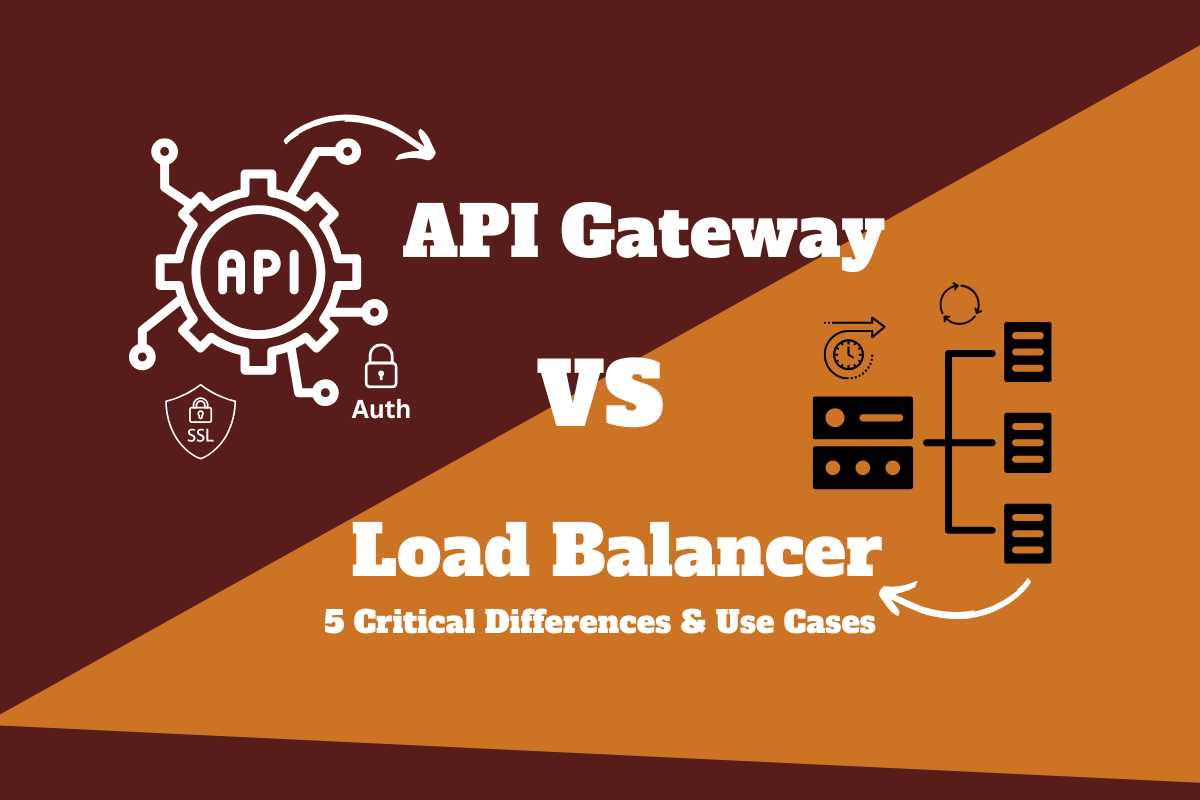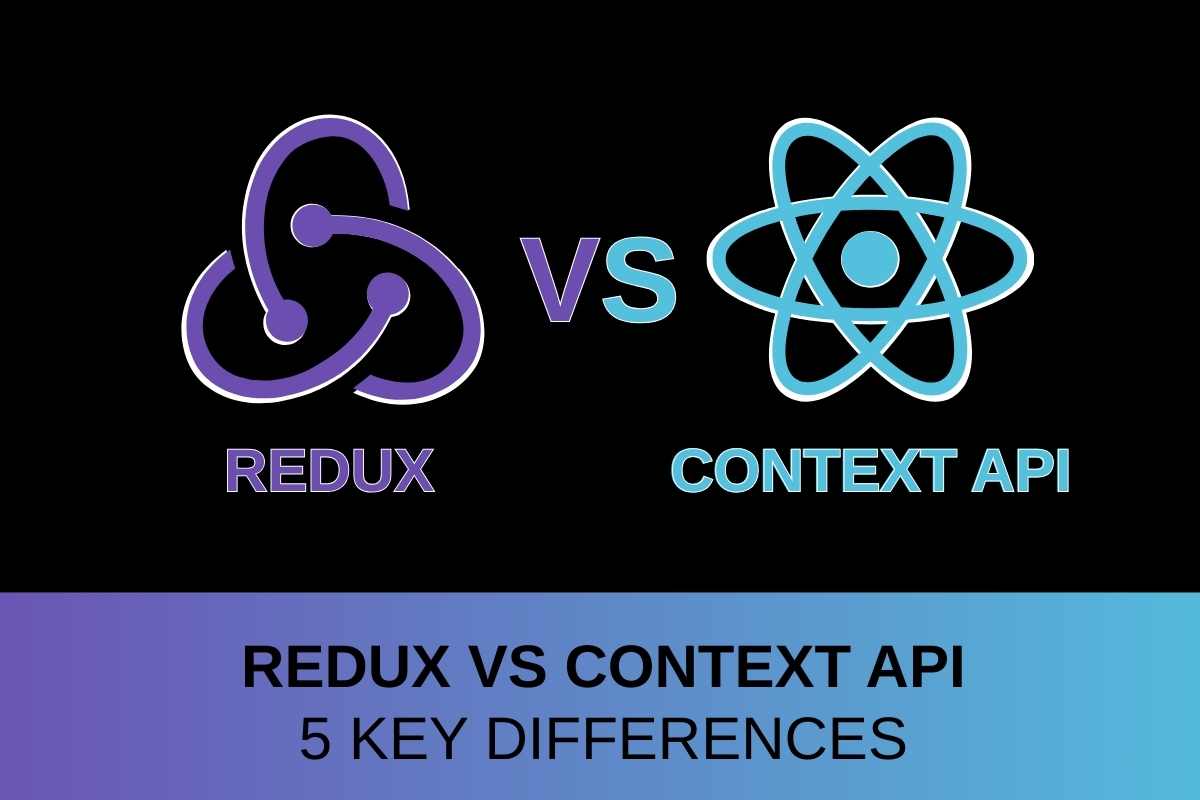What Is JavaScript Used For might sound like a simple question, but the answer’s huge. It stretches across web, mobile, desktop, and even cloud computing!!
JS is the undisputed king of programming languages! According to Stack Overflow surveys, it’s been the most popular language for a whopping 11 years in a row. As of 2024-2025, 62.3% of developers use JavaScript! That’s not just popular — that’s domination!
When I started teaching coding bootcamps (after ditching my retail job and moving from Russia to California with my wife), I was blown away by how JavaScript opened doors for my students. Even total beginners could create something interactive on day one!
In this article, I will explain 8 reasons why JavaScript is worth your time. From creating slick animations to powering the backend of major brands (like Walmart and PayPal), these reasons will show you why JS will continue to reign supreme in 2025 – 2026!
For more details, read “2025 Tech Job Market: Trends, Tips, and Top Opportunities“!
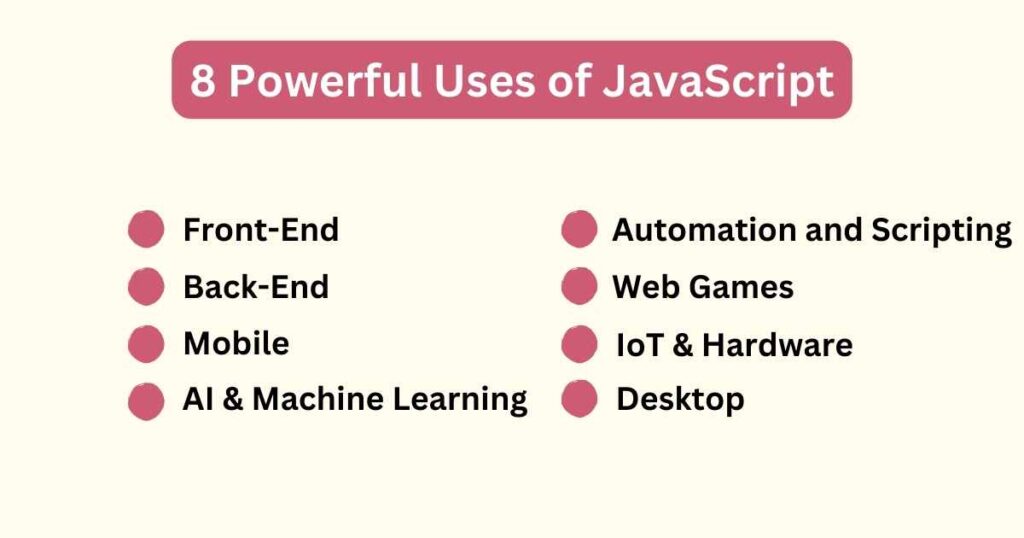
What Is JavaScript?
JavaScript is a programming language that allows websites to do cool stuff. Without it, web pages would just sit there like boring posters on the wall. When you see moving images, interactive maps, or forms — that’s JavaScript working!
Fun fact: even though it’s called “Java”Script, it’s not related to Java at all!! The name was mostly a marketing move to ride on Java’s popularity at the time.
It’s a scripting language that runs in a Browser and is dynamically compiled at runtime (with JIT compilation). It’s client-side, meaning it runs on your phone or computer, not some faraway server.
JavaScript was born in a crazy two-week coding sprint back in May 1995. A super smart Brendan Eich whipped it up while working at Netscape, an old-school browser company. They needed something to make websites more interactive, and boom — JavaScript was the answer!
Here’s a quick JS timeline:
| Year | What Happened |
|---|---|
| 1995 | JavaScript created — Brendan Eich |
| 1997 | Standardized as ECMAScript |
| 2009 | Node.js brings JS to servers |
| 2015 | ES6 (biggest update ever) released |
| Now | JS is everywhere — web, mobile, games, even smart TVs |
JavaScript got its big glow-up when it got standardized as ECMAScript. That’s just the official rulebook for how JS should work.
Today’s JS (ES6 and beyond) has arrow functions, promises, async/await, and many other features. It runs in your browser, using something called a JavaScript engine. Chrome uses V8, Firefox uses SpiderMonkey.
JS is slowly but surely eating the entire web-dev industry. It’s positioned to deliver on the promise of “write once, run anywhere” that Java never quite managed to achieve.
Today, a whopping 99% of websites use JavaScript to make their pages come alive. And it’s not just for websites anymore! With tools like Node.js, you can use JavaScript for server stuff, mobile apps, desktop programs, and even tiny computers.
Want to become a programmer? Read my “Complete Guide on How To Get Into IT“!
8 Powerful Uses of JavaScript — What Is JavaScript Used For?
JavaScript is the muscle behind modern websites, apps, and even games. Wanna build something that talks, moves, updates live, or just feels dope to use? You’re gonna need JS.
As we look ahead to 2025 – 2026, JavaScript’s popularity keeps growing. New frameworks like Svelte are gaining fans, and TypeScript is becoming a must-know language. The future of JS looks bright!!
Below are the 8 most common, real-world ways devs use JavaScript today.

1. Interactive Front-End Magic
JavaScript lets websites react to what you do. When you’re filling out a form, it tells you immediately if your password is strong enough. Or when maps let you zoom in and drag around to explore different areas.
How JavaScript benefits your web experience:
- Form validations: It’s when a site says: “Oops! Please enter a valid email”!
- Interactive maps: Drag, zoom, drop pins, Google Maps.
- Real-time updates: Reddit comments are showing up instantly — no refresh needed!
- Dropdown menus and sliders: Smooth moves on mouseover!
“Interactivity = engagement. More JS = more users sticking around.”
The real power of JavaScript comes from how it can manipulate the Document Object Model (DOM). Sounds fancy, but it’s just a way to represent all the elements on a webpage as objects that JS can play with. This means developers can add, remove, or change stuff on your screen.
Read more about “What Does A Front End Developer Do: 7 Core Responsibilities“!
JavaScript works right in your browser. This means faster experiences since the code runs on your device instead of constantly going to a server.
Users do not care what technologies you use. They only care that a website is fast and accessible. That’s the core of responsible JavaScript usage.
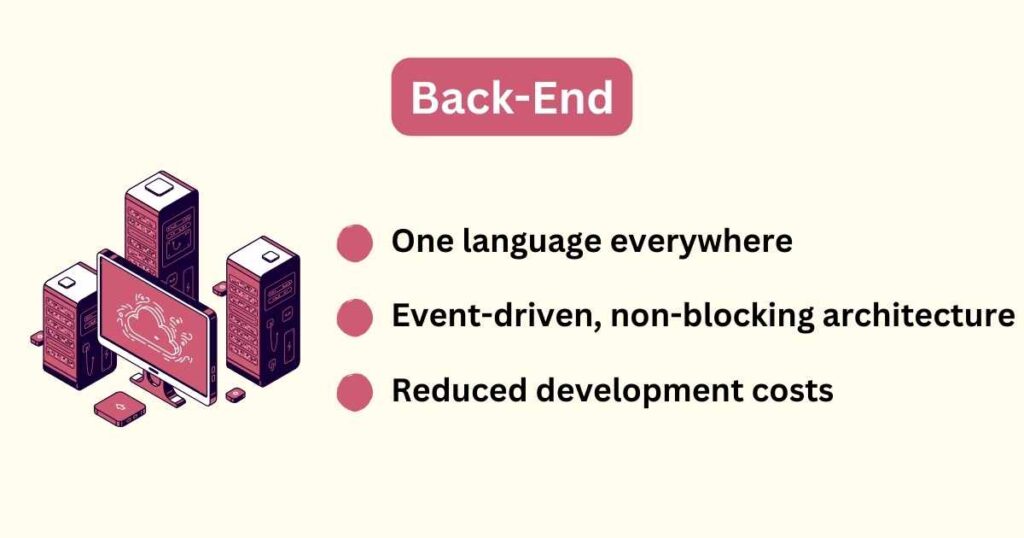
2. Full-Stack Freedom — Back-End Development with Node.js
Node.js pulled JavaScript out of the Browser in 2009. You can build entire back-end systems with the same language you use for front-end work — JS + Node!
What Is Node.js?
Node.js is built on Google Chrome’s super-fast V8 engine. It uses an event-driven, non-blocking I/O model. Node doesn’t just sit there when one task is waiting (like reading a file). It moves on to handle other requests and jobs and returns when the first task is ready.
This approach makes Node.js incredibly efficient for real-time applications. Chat apps, live streaming, and gaming platforms all benefit from this architecture.
Why It Matters?
Node lets you use JavaScript on both front and back ends. One language. Everywhere. That’s full-stack freedom. No jumping between Python, PHP, Java, Ruby, and JS. This means:
- Faster development time — no switching between languages.
- Easier team collaboration — everyone speaks JavaScript.
- Code reuse between client and server!
- Smaller learning curve for new developers!
Companies love this unified approach because it reduces development costs and speeds up project delivery.
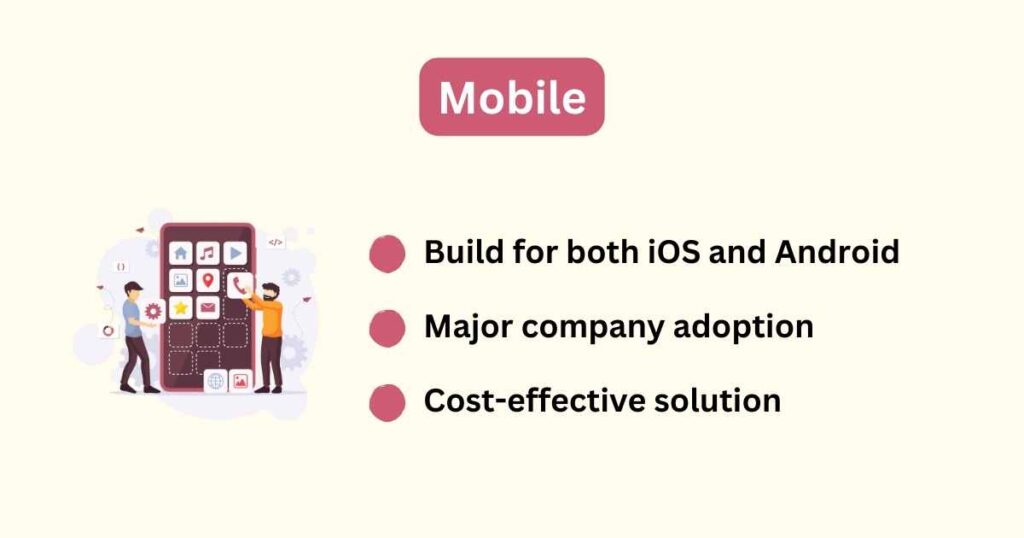
3. Mobile App Development – Mobile Apps via React Native & Ionic
Two major frameworks lead the JS mobile development — React Native and Ionic. Both let you build mobile apps without Swift, Java, or Kotlin.
JavaScript frameworks let you write once and run anywhere instead of building separate apps for iOS and Android. This cuts development time and costs!
React Native (by Facebook) bridges JavaScript code to native components. Ionic, as opposed to, uses web technologies — HTML, CSS, and JavaScript — to create hybrid apps. Both frameworks have their sweet spots.
Instagram switched to React Native in 2016. Discord built their entire mobile app with it from day one. Even Uber Eats relies on React Native!
Companies like T-Mobile, Disney, and Southwest Airlines trust Ionic for their mobile solutions.
The JavaScript mobile app market keeps growing. Statistics show 57.5% of users find mobile apps more practical than other platforms. That’s huge potential for JS devs!
Is It Fast, Though?
Good question. React Native and Ionic aren’t slow, but NOT native-level fast either. For most apps, it’s plenty fast. You’re golden unless you’re building 3D games or video editing tools. Some say: “React Native gets 90% of the speed for 50% of the cost. That’s a win!”
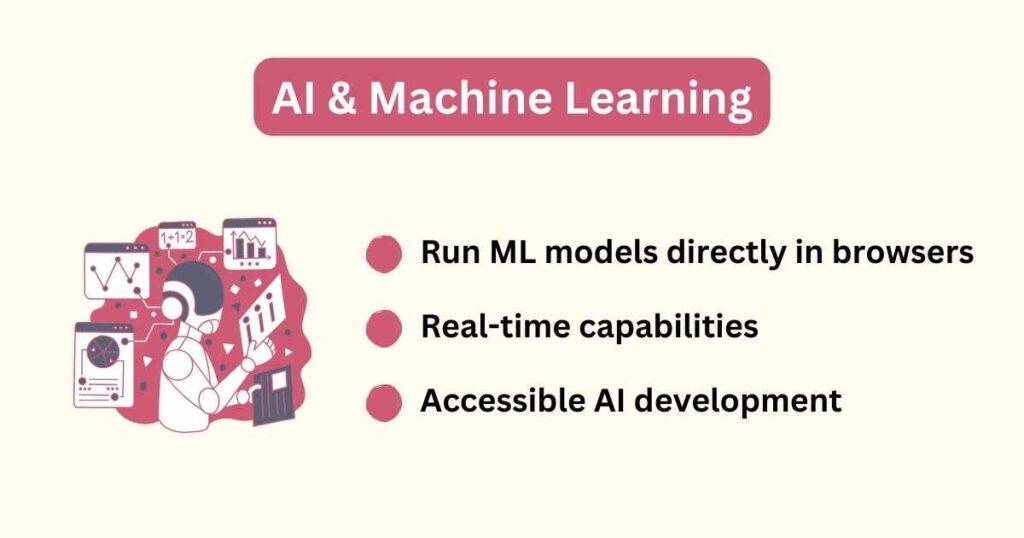
4. AI & Machine Learning in the Browser
JavaScript lets you run ML scripts right in your browser! You’d need a server setup back in the day, but now? You can do all that stuff right on your laptop or phone!
TensorFlow.js is a JavaScript library that builds and runs machine learning models directly in the browser. You can use pre-trained models or create your own from scratch using JavaScript. These ML apps mainly include facial recognition and pose detection.
Another fun example is PoseNet, which tracks human body positions in real time with just your webcam. The tech detects different joints in your body from the webcam feed and figures out your pose.
Most modern browsers can handle TensorFlow.js models or the PoseNet project just fine! So yeah, JavaScript is powering the AI revolution in your Chrome or Firefox!
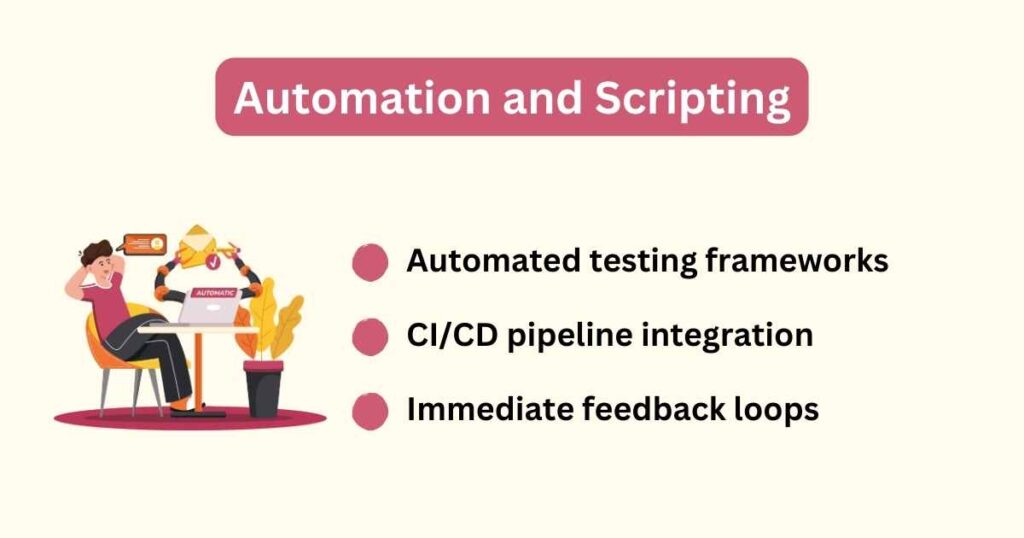
5. Automation, Scripting, and Testing
Manual testing takes forever, and humans make mistakes. JavaScript automation fixes both problems fast!
Modern frameworks — Jest, Mocha, and Cypress — make testing super easy! These tools let you write tests that run automatically. No more clicking buttons for HOURS!
JS automation saves tons of time (and sanity). You can automate file processing, data migration, and deployment tasks.
Node.js makes server-side automation possible. Build scripts that run on schedules. Deploy code automatically when tests pass. Modern development uses JS for CI/CD (Continuous Integration/Continuous Deployment) pipelines, too! GitHub Actions, CircleCI, and Jenkins run automatically when you push code.
JavaScript automation creates better workflows. Developers write code, tests run automatically, and deployment happens seamlessly. The feedback loop gets faster. You know IMMEDIATELY if something breaks!
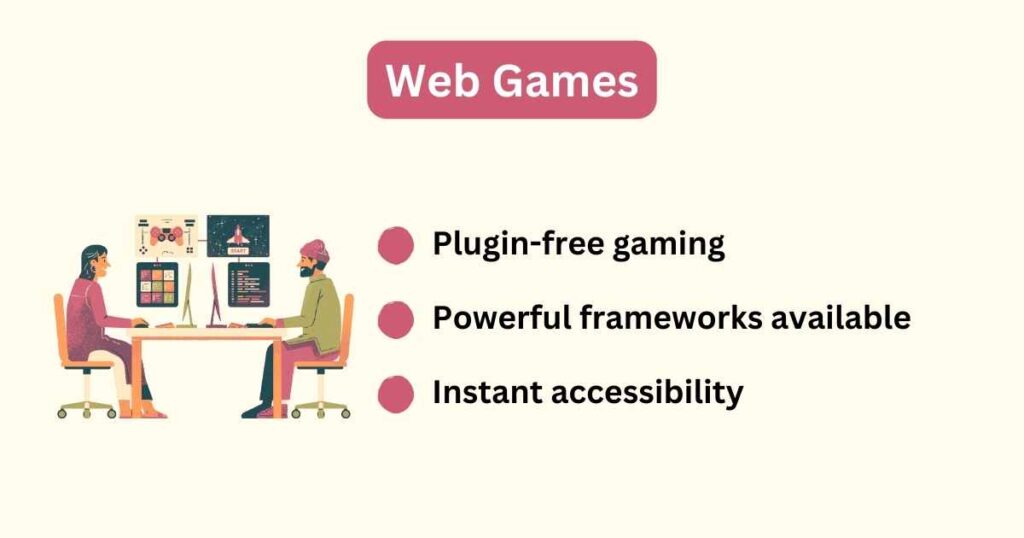
6. What Is JavaScript Used For In Web Game Development – Games in the Browser
Modern web browsers can handle complex 2D and 3D graphics without plugins. This makes JavaScript perfect for reaching millions of players instantly.
Several popular JS game dev frameworks:
- Phaser – Perfect for 2D games with built-in physics and animations
- Three.js – Handles 3D graphics and WebGL rendering beautifully
- Babylon.js – Microsoft-backed engine for high-end 3D experiences
- Pixi.js – Lightning-fast 2D rendering with excellent mobile support
- Matter.js – Adds realistic physics to your games
These tools handle the heavy lifting and provide ready-made graphics, sound, and game mechanics.
JavaScript works best for specific game types:
| Game Type | Good Fit for JS? | Examples |
|---|---|---|
| Puzzle Games | ✅ Best fit | 2048, Little Alchemy |
| Platformers | ✅ Great choice | Kiwi.js Demos |
| RPGs (Lite) | ✅ Possible | BrowserQuest |
| 3D Shooters | ⚠️ Tough call | Some Three.js demos |
| Real-Time Games | ⚠️ Limited speed | Multiplayer games (small) |
Many popular games use JavaScript as their foundation. CrossCode became a hit RPG with quests and skill trees. Gods Will Be Watching gained critical acclaim for its storytelling. Even mobile hits like Words With Friends 2 use React Native.
Browser-based games reach players instantly — no downloads required! This accessibility gives JavaScript games a MASSIVE advantage over traditional titles.

7. Internet of Things Applications – IoT & Hardware
You can control lights, sensors, and motors using the same JavaScript code you write for web apps.
JavaScript’s event-driven nature makes it perfect for IoT projects. Devices need to respond to multiple things at once, like reading sensors while sending data. JavaScript handles these tasks without blocking other operations.
Common JavaScript frameworks for IoT development:
- Johnny-Five: Controls hardware like LEDs, motors, and sensors across different boards
- Cylon.js: Supports over 50 different IoT platforms and devices
- Espruino: Runs JavaScript directly on microcontrollers like ESP32
- IoT.js: Works on devices with just a few kilobytes of RAM
The language also runs on tiny devices through special engines. JerryScript lets you run JavaScript on microcontrollers with very little memory. For bigger devices like Raspberry Pi, you can use full Node.js.
JS in IoT isn’t perfect. It’s not as fast or low-power as languages like C or Rust. Use something lighter if you’re running a battery device 24/7. Also — security matters and JS need extra care with it.
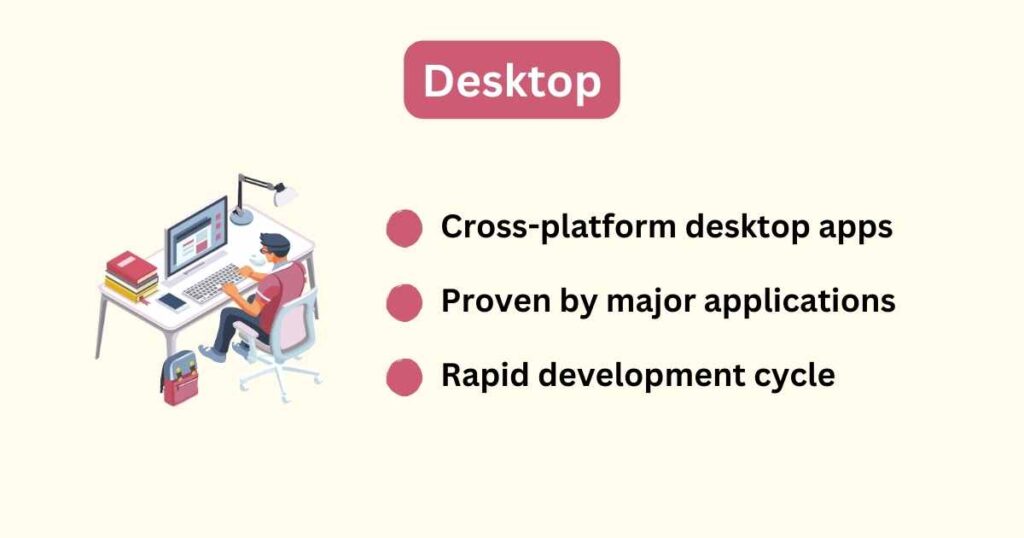
8. Desktop Application Development – Desktop Apps with Electron
Electron embeds Chromium and Node.js to create desktop applications using JavaScript, HTML, and CSS. You can build cross-platform apps on Windows, macOS, and Linux! Other common frameworks are NW.js and Proton Native.
The framework provides access to the computer’s file system and native operating system features.
Visual Studio Code demonstrates the potential of Electron. Slack and Discord showcase feature-rich experiences. Other examples include GitHub Desktop, WordPress Desktop, and the original Atom editor for which Electron was initially created.
Electron apps typically consume MORE resources than native applications. Each Electron app runs its instance of the Chromium browser, consuming more resources.
However, the performance gap is narrowing. Modern JS frameworks use “lazy loading” and “asynchronous components” to improve speed. For many use cases, the development speed and cross-platform benefits outweigh the performance costs!
Conclusion — What Is JavaScript Used For?
JavaScript powers almost everything we see online today. From websites to mobile apps, server development to AI projects – JS does it all.
JavaScript lets you build websites, create mobile apps, develop games, or even program flying robots. The language works everywhere – browsers, servers, mobile devices, and IoT gadgets.
Here’s my take: Learning JavaScript opens more doors than ANY other programming language! It’s beginner-friendly, has massive community support, and offers endless career paths. Read my next post about “How To Get Into IT Without a Degree in 2025“!



